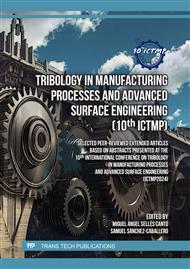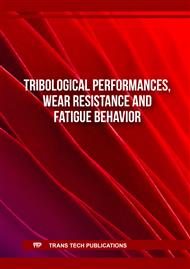[1]
Size, D. I. M., & Growth, D. I. M. S., Share & Trends Analysis Report By Product (Titanium Implants, Zirconium Implants), By Region (North America, Europe, Asia Pacific, Latin America, MEA) …: Personalized Medicine Market Analysis By Product And Segment Forecasts To 2022 (2018), 2018.
Google Scholar
[2]
J. Cao and M. Banu, "Opportunities and challenges in metal forming for lightweighting: review and future work," Journal of Manufacturing Science and Engineering, vol. 142, no. 11, p.110813, 2020.
DOI: 10.1115/1.4047732
Google Scholar
[3]
K.-D. Bouzakis et al., "Effect of the cutting edge radius and its manufacturing procedure, on the milling performance of PVD coated cemented carbide inserts," CIRP Annals, vol. 51, no. 1, p.61–64, 2002.
DOI: 10.1016/s0007-8506(07)61466-8
Google Scholar
[4]
T. Trzepieciński, "Recent developments and trends in sheet metal forming," Metals, vol. 10, no. 6, p.779, 2020.
DOI: 10.3390/met10060779
Google Scholar
[5]
M. Sigvant et al., "Friction in sheet metal forming: Influence of surface roughness and strain rate on sheet metal forming simulation results," Procedia Manufacturing, vol. 29, p.512–519, 2019.
DOI: 10.1016/j.promfg.2019.02.169
Google Scholar
[6]
W. Colglazier, "Sustainable development agenda: 2030," Science (New York, N.Y.), vol. 349, no. 6252, p.1048–1050, 2015.
DOI: 10.1126/science.aad2333
Google Scholar
[7]
N. Bay et al., "Environmentally benign tribo-systems for metal forming," CIRP Annals, vol. 59, no. 2, p.760–780, 2010.
DOI: 10.1016/j.cirp.2010.05.007
Google Scholar
[8]
Regulation (EC) No 1907/2006 of the European Parliament and of the Council of 18 December 2006 concerning the Registration, Evaluation, Authorisation and Restriction of Chemicals (REACH), establishing a European Chemicals Agency: 2006. [Online]. Available: https://eur-lex.europa.eu/legal-content/EN/TXT/?uri=CELEX%3A02006R1907-20230629
DOI: 10.1016/j.fos.2016.03.026
Google Scholar
[9]
D. Patel, V. K. Jain, and J. Ramkumar, "Micro texturing on metallic surfaces: State of the art," Proceedings of the Institution of Mechanical Engineers, Part B: Journal of Engineering Manufacture, vol. 232, no. 6, p.941–964, 2018.
DOI: 10.1177/0954405416661583
Google Scholar
[10]
F. Saeidi, M. Parlinska-Wojtan, P. Hoffmann, and K. Wasmer, "Effects of laser surface texturing on the wear and failure mechanism of grey cast iron reciprocating against steel under starved lubrication conditions," Wear, vol. 386, p.29–38, 2017.
DOI: 10.1016/j.wear.2017.05.015
Google Scholar
[11]
Shimizu, Kobayashi, Vorholt, and Yang, "Lubrication Analysis of Micro-Dimple Textured Die Surface by Direct Observation of Contact Interface in Sheet Metal Forming," Metals, vol. 9, no. 9, p.917, 2019.
DOI: 10.3390/met9090917
Google Scholar
[12]
K. Kitamura, T. Makino, M. Nawa, and S. Miyata, "Tribological effects of punch with micro-dimples in blanking under high hydrostatic pressure," CIRP Annals, vol. 65, no. 1, p.249–252, 2016.
DOI: 10.1016/j.cirp.2016.04.133
Google Scholar
[13]
C. Lechner, F. Bleicher, C. Habersohn, C. Bauer, and S. Goessinger, "The use of machine hammer peening technology for smoothening and structuring of surfaces," in Annals of DAAAM for 2012 & Proceeding of the 23rd International DAAAM Symposium, p.331–337.
DOI: 10.2507/23rd.daaam.proceedings.077
Google Scholar
[14]
J. R. Hönnige, P. Colegrove, and S. Williams, "Improvement of microstructure and mechanical properties in wire+ arc additively manufactured Ti-6Al-4V with machine hammer peening," Procedia Engineering, vol. 216, p.8–17, 2017.
DOI: 10.1016/j.proeng.2018.02.083
Google Scholar
[15]
B. Adjassoho, E. Kozeschnik, C. Lechner, F. Bleicher, S. Goessinger, and C. Bauer, "Induction of residual stresses and increase of surface hardness by machine hammer peening technology," Annals of DAAAM, vol. 23, no. 1, p.697–702, 2012.
DOI: 10.2507/23rd.daaam.proceedings.163
Google Scholar
[16]
M. Steitz, P. Stein, and P. Groche, "Influence of Hammer-Peened Surface Textures on Friction Behavior," Tribol Lett, vol. 58, no. 2, 2015.
DOI: 10.1007/s11249-015-0502-9
Google Scholar
[17]
P. Sticht, J. Hohmann, and P. Groche, "Effects of Machine Hammer Peened Surface Textures on the Tribological Behavior of Stamping Tools," in 2020, p.108–120. [Online]. Available: https://link.springer.com/chapter/10.1007/978-981-15-0054-1_12
DOI: 10.1007/978-981-15-0054-1_12
Google Scholar
[18]
P. Schumann, P. Groche, and R. Lindner, "Influence of different determinsistic surface texturing processes on friction and tool life for load collectives in sheet metal forming," Proceedings of the SICT / Plasma Tech / Tribology 2023 International Joint Conferences 2023, 2023, pp.42-47
Google Scholar
[19]
Y. Uehara, M. Wakuda, Y. Yamauchi, S. Kanzaki, and S. Sakaguchi, "Tribological properties of dimpled silicon nitride under oil lubrication," Journal of the European Ceramic society, vol. 24, no. 2, p.369–373, 2004.
DOI: 10.1016/s0955-2219(03)00220-6
Google Scholar
[20]
P. Schumann, D. Martin, C. Kubik, and T. Schneider, "Analysis and Evaluation of the Clamping Force on the Tool Surface During the Blanking Process," NUMISHEET 2022: Proceedings of the 12th International Conference and Workshop on Numerical Simulation of 3D Sheet Metal Forming Processes, 2022.
DOI: 10.1007/978-3-031-06212-4_60
Google Scholar
[21]
P. Schumann and P. Groche, "Ressourceneffiziente Prozesse durch modifizierte Werkzeugoberflächen: Mittels Mikrostrukturierung durch maschinelles Oberflächenhämmern zur nachhaltigen Produktion," Zeitschrift für wirtschaftlichen Fabrikbetrieb, vol. 119, 1-2, p.75–79, 2024.
DOI: 10.1515/zwf-2024-1021
Google Scholar
[22]
J. Hohmann, T. Schatz, and P. Groche, "Intelligent wear identification based on sensory inline information for a stamping process," in Proceedings of 5th International Conference on Advanced Manufacturing Engineering and Technologies: NEWTECH 2017 5, p.285–295.
DOI: 10.1007/978-3-319-56430-2_21
Google Scholar



